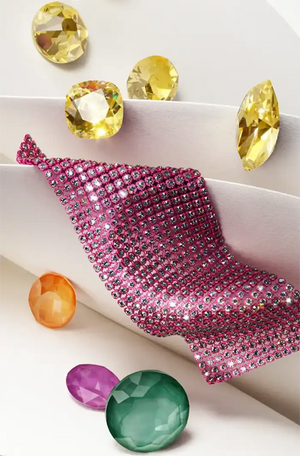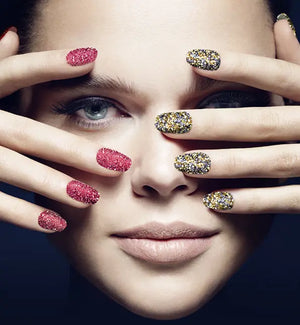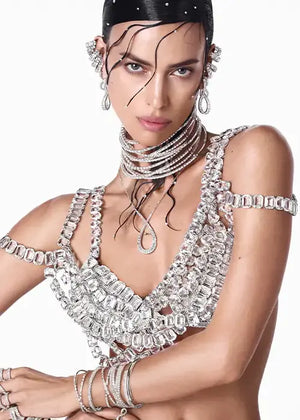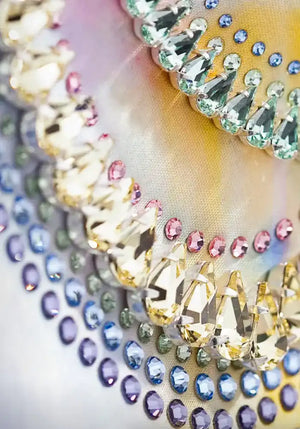
Ultimate Guide To Applying Crystals Onto Fabric
How can we tell when it is a special occasion? Very often we take our cues from the clothing being worn by the people around us to establish whether a situation is casual, business formal or intended as a true celebration of life! It is the reason dress codes exist and a sure sign of an occasion’s importance is the amount of sparkle you find on the garments people choose to wear. Sparkly shoes for instance, is the difference between a Wednesday afternoon lunch break and a Saturday night out!
The great thing about crystal embellishment is that it gives you the ability to take any shop bought or handmade item and regardless of how simple the design is, it can become absolutely fabulous! The creative possibilities are near limitless when it comes to applying glitz to your garments and to give you the widest possible scope to explore your creativity, we have included several key tools and techniques in this ultimate guide, let’s start with…
The Basics
Whenever working with clothing, whether sewing something new or modifying something old, you need to consider your workspace. It might feel appealing to curl up on the sofa with some needlework while you watch TV in cozy lighting, munching your way through a pastry as you go, but you are making choices that will make the task more difficult to complete and mistakes more likely. Here are a few key things that we recommend aiming for.
A large, well-lit work surface like a dining table is great for laying out your item so that everything can sit smooth and flat. This enables you to easily see the full impact of every choice you make throughout the process. Having the lights fully on your work also prevents eye strain, while you focus on details that can be tiny and repeated many times over.
Avoid handling food while working with crystals, threads, or garments because grease, sugar and crumbs can cause unwanted fingerprints and make tools slippery. If you want to eat, do so in a separate location and wash your hands before handling the project again.
Keeping track of where everything is while you work makes a massive difference to how pleasant any craft can be, too much time is lost to frustratedly searching for misplaced things. Storage solutions for your materials and tools is key to a stress-free craft, have a place for your threads, a place for your needles and a place for your crystals and keep them separate and organised throughout as much as you can.
We understand that not all circumstances allow for optimised workspaces, sometimes the floor is the best you can find and as long you take care of your posture and listen to your body throughout, having creative fun while crafting is the goal.
When deciding to add crystals to clothes there are many different methods and these all yield different results. We have broken them down into categories that will help you choose your direction based on existing classic fashion trends.
Red Carpet and Ballroom: The Gown
Anyone who is interested in fashion or crystals is likely to spend a considerable portion of their life, admiring the pantheon of celebrities as they saunter down the red carpet, adorned in the latest designer creations. Often these same celebrities can be found on popular competition shows like Strictly Come Dancing, where their fame is combined with the glitz of ballroom dance to create a heady alchemy of dazzling Show Bizz Buzz!
The swooshing gown that sparkles from every angle is a staple from catwalk, to premier, to dance floor. The types of embellishments used often need to draw the full weight of the audience’s gaze, while in fact being as lightweight as possible to enable the flow of the fabric and minimise the amount of bulk added to the silhouette.
Delicate lace embroidered with sew on crystals are one of the major ways this exquisite effect is achieved. Sew on crystals are different from other flatback crystals because they have strategically located holes cut into them. This is so that a needle and thread can be passed through, attaching them to your material of choice. The location of the sewing holes will vary depending on the design of the stone and this may affect how you to choose to use them in your embellishment.
Preciosa Loch rose sew on crystals (one hole) have the hole positioned in the centre of the crystal and are very similar to sequins in appearance. This style of crystal is usually used in conjunction with a small bead that will act as a stopper. The thread will be passed up through the loch rose from behind, up through the stopper bead and back down through the loch rose into the fabric. This is great for both texture and coverage and you can also mix and match the colours and types of beads you use as the stopper. A popular combination is to combine loch rose crystals with rocaille beads, also known as Preciosa seed beads as seen:
Loch rose crystals with two holes can be sewn on without the use of stopper beads and like the one-hole version, they are always round in shape. This is because the “rose” of “loch rose” is referring the cut of the crystal, similar to Chaton Rose and Xillion Rose crystals; all of these styles are essentially round when viewed from the front.
Other more uniquely shaped sew on crystals usually have two or more holes in their design and these are typically at either end of the shape, this enables them to be securely stitched into place with minimal risk of a corner catching on something and then getting tugged off the garment. We highly recommend sewing through every available hole in the crystal as this has been designed for maximum stability.
TIP: Use a small quantity of Gem Tac glue to temporarily hold your sew on crystals in place while you apply your stitches. This will ensure the crystal remains in the correct position and orientation while you are sewing. Gem Tac is water based so the glue will dissolve away with the first wash, making the stitches the primary method of attachment. This trick is especially useful when you are building a design of many crystals that form a pattern, where the spacing and location of every stone really matters.
Bold Beachwear Beads
Beads are the original form of adornment; we learned centuries ago that anything can be a bead if you drill a hole through it and this makes beads universal. So, it is natural to associate the look and feel of beads with being on holiday because no matter where you are on the planet, beads are there in the culture. Sewing beads onto fabric is a great way of adding texture, colour and a satisfying heft to your embroidery.
We recommend using beading needles, which are thinner than the average sewing needle and will prevent the eye getting caught in the bead hole that can sometimes be tiny! The most popular styles of cut-glass beads are Preciosa bicone and round beads because of their regularity in shape and their ability to sparkle in the light. There are also the smoother and much smaller Rocaille beads (AKA seed beads) which can be woven together in vast quantities to build beautiful patterns. The best bit about beads is their individual simplicity and the fun is found in combining them with different types of stitch to create limitless possible designs.
Perfect Pearls
Glass pearls are unique because they are perceived slightly differently to the other decorative options in this guide. Depending on the circumstances you find yourself in, sparkling crystals on an outfit could be considered “a bit too much”, whereas pearls on the other hand strike a balance between extravagant and restrained. For example, no one would question wearing pearls to a funeral, whereas a diamond tiara might get some raised eyebrows.
Fully drilled Preciosa pearls can be sewn on much like the bicone and round beads described previously, this is because they also usually fully drilled. This style of pearl is primarily meant for necklaces so it’s very common to see pearls used around the neckline of a dress.
Pearls also come in a Cabochon style meaning they are flat on the back and domed on the front, this lends itself to fabric glue applications or placed in metal settings to then be sewn on to clothes.
Pearls are frequently found on outfits that want to suggest a sense of sophistication and classical grace, this is due to pearls being historically linked with innocence combined with authority. Aphrodite is depicted emerging from a shell and Queen Elizabeth 1st was famous for wearing pearls to push the idea of The Virgin Queen. If you wear pearls, you imply a connection to these icons of pure femininity.
Bridal Bling
The more extravagant embellishments are often reserved for the most significant occasions. For many people across most cultures, the biggest occasion of their life is their wedding day and the bridal ensemble is expected to form the focal point in the celebrations. This expectation calls for a certain level of grandeur, and crystals encased in gold or silver metal settings can provide this in abundance.
A fast and effective way to neatly apply long rows of crystals, is to attach crystal cup chains. These are long stands of crystals in interconnected metal settings that are able to slide a small distance apart from each other because of the way they are linked together. This gives the chain the flexibility to curve in multiple directions, perfect for outlining shapes with a flawless row of crystals. Preciosa cup chains vary in bulk depending on the size of the crystals used in the chain, for instance an SS4 crystal cup chain is going to look very delicate because SS4 is a small crystal, whereas an SS29 crystal cup chain will make a big impression. Cup chains can also be comprised of other shapes such as baguette, which will give a different final look and makes them well suited to collars and hemlines.
You can also use Preciosa single stones in settings, which are usually crystals that have a shaped back to them, like a fancy stone or a pointed back chaton, these are encased in a specially designed metal component that adapts them to be suitable for flat surfaces. When a crystal in set into a metal casing there are two major easily recognisable styles; the Tiffany setting uses several delicate metal prongs that sit around the outer edge of the crystal and are bent so that they gently clasp the glass in a claw like grip. This style is associated with the classic engagement ring and allows you to see the sides of the stone allowing plenty of light to shine into the glass for sparkle, you will find this style on our Rose Montees and other single stone settings. The one thing to be aware of with this style of setting is those prongs can hook onto loose fibers that rub against them, so care should be taken with crystal placement if they are being applied to fluffy or lacy fabrics.
The other major style is the rim setting, this involves the entire outline of the crystal being encased in a solid strip of mental that is pressed tight around the edge with no gaps. This leaves no corners to catch onto anything and presents a simpler, smoother appearance. Rim settings are most often found on rivets and on several jewellery settings where glue is also used to set the crystal.
Stones in a setting are suited to embellishments and jewellery craft because the metal setting can be soldered onto another piece of metal, or if the setting has holes in the sides, it can be sewn onto fabric. This makes them great for adding dimension to your design because they are bulkier than flatback crystals and the metal element adds a luxurious weight to the finished piece. These are typically incorporated around the neckline to catch the light and draw attention towards the face.
Similar to sew on crystals where the hole is cut through the glass, crystals in metal settings have a set amount of sewing holes provided, make sure you have sewn through every available hole to guarantee it is as secure as possible.
Rock’n’roll Rivets
There is an unmistakable sense of strength associated with rivets, studs and any adornment that focuses on metal. It can be traced back to the plated armour of medieval knights and ancient Romans. A rivet is the stamped stitch that is stomped between two materials that are too hard to be pierced by any other means. This association with combat is carried forward into modern counterculture fashions. Punk loves the shiny silver spike on collars and ripped denim, Rock’n’roll loves the rivet on black leather chaps and jackets. When you attach rivets, studs or rose pins to your outfit, you are adding toughness as well as style.
Preciosa Rivets come in two parts that need to go on either side of the material and then be punched firmly through the fabric into each other, so that they are interlocked permanently. The amount of force required for this is considerable and specialist tools have been developed to make the process as easy as possible. Large scale rivet applications call for the table mounted Fly Press and smaller embellishments can be achieved with the handheld Applicator Pliers. Both the Fly Press and the Applicator Pliers are combined with rivet or rose pin Die Sets that provide the perfect shapes for holding the two sides of the rivet, stud or rose pin secure within the tool. Simply slot everything into place, line the tool up with where you want the stud to go and press!
The Competition Leotard
Despite what you have read so far, not all crystals need to be sewn or riveted into place in order to stay on fabric. Preciosa Hotfix flatback crystals are designed specifically with fabric application in mind and the clue to the method is in the name; get them ‘hot’ to ‘fix’ them onto fabric. This style of flatback crystal has a layer of heat reactive glue on the underside, that melts at high temperatures and grips onto the fabric when it cools back down and sets. The temperature required to melt this glue is very high, to guard against the crystals melting off whenever the garment is washed, therefore a specialised heat tool is needed.
Enter the Hotfix Applicator, this tool has a precision tip that provides a concentrated point of heat that is similar to a soldering iron or pyrography pen. To apply hotfix crystals, simply place the crystal onto your fabric with the glue side facing down and when the tool is hot enough, press the tip down on to the crystal and hold for approximately ten seconds until the glue is melted, then remove the pressure. Larger crystals may take longer because you are waiting for the heat to conduct from the tool, through the glass and down into the glue.
Preciosa Hotfix Crystals sit completely flush with the fabric with minimal friction and the specialised glue can endure the stretching of fabric better than other types of glue out there. Therefore, it beats the competition and is the first choice when embellishing leotards for gymnasts, ice skaters and any performer who needs to be able to flex and stretch and test the limits of both their body and clothing without concern.
Conclusion
We hope you have found this comprehensive guide informative but most of all, inspiring! We at Bluestreak Crystals love seeing what you do with our products and if you have been inspired to revolutionise your wardrobe, we encourage you to post your creations online and tag us @bluestreakcrystals so that you too, can be a part of #teambluestreak







